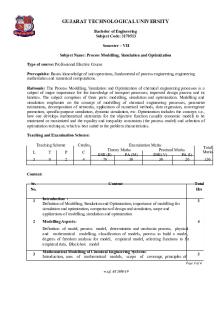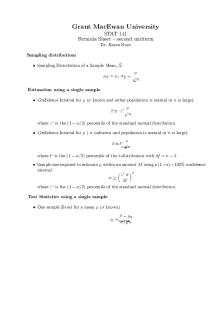Lecture Notes 2 h PDF

| Title | Lecture Notes 2 h |
|---|---|
| Course | Advanced Accounting |
| Institution | Brandman University |
| Pages | 2 |
| File Size | 52 KB |
| File Type | |
| Total Downloads | 31 |
| Total Views | 148 |
Summary
These lecture notes were written for the ACCU 401 Course taught by Professor Gerald Lege....
Description
Consolidation Worksheet Entries 2. Acquisition-date financial information for parent (after journal entry for the investment and combination costs) and sub is recorded in the first two columns of the worksheet (sub’s prior revenue and expense already closed). 3. Remove the sub’s equity account balances and remove the Investment in Sub balance (Entry S). 4. Remove the excess payment in the investment account at acquisition date and assign it to the specific accounts indicated by the fair-value allocation schedule (Entry A).
2. The consolidation process begins with preparing the first two columns of the worksheet (see Exhibit 2.6) containing the separate companies’ acquisition-date book value financial figures (see Exhibit 2.3). BigNet’s accounts have been adjusted for the journal entries recorded earlier for the investment and the combination costs. As another preliminary step, Smallport’s revenue, expense, and dividend accounts have been closed into its Retained Earnings account. The subsidiary’s operations prior to the December 31 takeover have no direct bearing on the operating results of the business combination. These activities occurred before Smallport was acquired; thus, the new owner should not include any precombination subsidiary revenues or expenses in the consolidated statements. 3. Consolidation Entry S eliminates Smallport’s stockholders’ equity accounts (S is a reference to beginning subsidiary stockholders’ equity). Consolidation Entry S is a worksheet entry and accordingly does not affect the financial records of either company. The subsidiary balances (Common Stock, Additional Paid-In Capital, and Retained Earnings) represent ownership interests held by the parent in their entirety and thus no longer are outstanding. By removing these account balances on the worksheet, only Smallport’s assets and liabilities remain to be combined with the parent company figures. Consolidation Entry S also removes the $600,000 component of the parent’s Investment in Smallport Company account balance that equates to the book value of the subsidiary’s net assets. For external reporting purposes, BigNet should include each of Smallport’s assets and liabilities rather than a single investment balance. In effect, this portion of the parent’s Investment in Smallport Company account balance is deleted and replaced by the specific subsidiary assets and liabilities that are already listed in the second column of the worksheet. 4. Consolidation Entry A removes the excess payment in the Investment in Smallport Company and assigns it to the specific accounts indicated by the fair-value allocation schedule. Consequently, Computers and Equipment is increased by $200,000 to agree with Smallport’s fair value: $1,100,000 is attributed to Capitalized Software, $700,000 to Customer Contracts, and $50,000 to Notes Payable. The unidentified excess of $70,000 is allocated to Goodwill. This consolidation worksheet entry is labeled Entry A to indicate that it represents the Allocations made in connection with Smallport’s acquisition-date fair value. It also completes the Investment in Smallport Company account balance elimination on the worksheet.
Acquisition Method—Consolidation Workpaper Journal Entries Consolidation Entry S eliminates Smallport’s stockholders’ equity accounts as shown. Consolidation Entry A removes the $2,020,000 excess payment in the Investment in Smallport Company and assigns it to the specific accounts indicated by the fair-value allocation schedule as shown.
5. Combine all account balances and extend into the Consolidated Totals column. 6. Subtract consolidated expenses from revenues to arrive at net income.
5. All accounts are extended into the Consolidated Totals column. For accounts such as Current Assets, this process simply adds Smallport and BigNet book values. However, when applicable, this extension also includes any allocations to establish the acquisition-date fair values of Smallport’s assets and liabilities. Computers and Equipment, for example, is increased by $200,000. By increasing the subsidiary’s book value to fair value, the reported balances are the same as in the previous example when dissolution occurred. The use of a worksheet does not alter the consolidated figures but only the method of deriving those numbers. 6. We subtract consolidated expenses from revenues to arrive at net income. Note that because this is an acquisition-date worksheet, we consolidate no amounts for Smallport’s revenues and expenses. Having just been acquired, Smallport has not yet earned any income for BigNet owners. Consolidated revenues, expenses, and net income are identical to BigNet’s balances. Subsequent to acquisition, of course, Smallport’s revenue and expense accounts will be consolidated with BigNet’s
Describe the accounting treatment for the various intangible assets often acquired in a business combination.
Acquisition-Date Fair-Value Allocations In determining whether to recognize an intangible asset in a business combination, two specific criteria are essential. Intangible assets: Arise from contractual or other legal rights (most intangibles in business combinations meet the contractual-legal criterion). Are capable of being sold or otherwise separated from the acquired enterprise....
Similar Free PDFs

Lecture Notes 2 h
- 2 Pages

3170513 - Lecture notes H
- 4 Pages

Lecture Notes 4 h
- 3 Pages

GST- Challan - Lecture notes H
- 2 Pages

H. ART Antic - Lecture notes 1-11
- 18 Pages

Lecture notes, lecture 2
- 3 Pages

2 - Lecture notes 2
- 5 Pages

Lecture notes, lecture Chapter 2
- 11 Pages

Lecture notes, lecture formula 2
- 1 Pages

H - Native America Notes
- 4 Pages
Popular Institutions
- Tinajero National High School - Annex
- Politeknik Caltex Riau
- Yokohama City University
- SGT University
- University of Al-Qadisiyah
- Divine Word College of Vigan
- Techniek College Rotterdam
- Universidade de Santiago
- Universiti Teknologi MARA Cawangan Johor Kampus Pasir Gudang
- Poltekkes Kemenkes Yogyakarta
- Baguio City National High School
- Colegio san marcos
- preparatoria uno
- Centro de Bachillerato Tecnológico Industrial y de Servicios No. 107
- Dalian Maritime University
- Quang Trung Secondary School
- Colegio Tecnológico en Informática
- Corporación Regional de Educación Superior
- Grupo CEDVA
- Dar Al Uloom University
- Centro de Estudios Preuniversitarios de la Universidad Nacional de Ingeniería
- 上智大学
- Aakash International School, Nuna Majara
- San Felipe Neri Catholic School
- Kang Chiao International School - New Taipei City
- Misamis Occidental National High School
- Institución Educativa Escuela Normal Juan Ladrilleros
- Kolehiyo ng Pantukan
- Batanes State College
- Instituto Continental
- Sekolah Menengah Kejuruan Kesehatan Kaltara (Tarakan)
- Colegio de La Inmaculada Concepcion - Cebu





